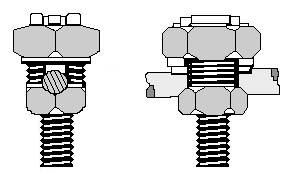Electrical motor windings are normally insulated from all mechanical parts of the motor. However, if the insulation system should fail, then the motor frame could become energized at line voltage. Any person contacting a grounded surface and the energized motor frame simultaneously could be severely injured or killed. Grounding the motor frame prevents this possibility.
The National Electrical Code (NEC), section 430-L, defines the conditions that dictate when motor grounding is required. These conditions come down to the simple fact that essentially all industrial motors must be grounded.
The most common method of providing for grounding in NEMA motors is a ground lug under one of the conduit box mounting bolts. This is standard in CORRO-DUTY® motors.
However there are two commonly used methods of supplying grounding provisions on large motors. Both methods effectively create a solid electrical connection directly to the stator laminations so that any insulation failure is grounded through the ground conductor attached to the motor by the end user.
The most common method is to use a grounding connector. Those used in U. S. MOTORS® products include Burndy Servit®† Posts, Scrulugs®†, and KA-Lug®† (To view a grounding connector click on associated tradename). This connector is placed either in the main outlet box or into the motor's frame. When installed in the main outlet box, the servit post is used as a mounting bolt for the box so that it threads directly into the frame. Outside the box, it is screwed into a drilled and tapped hole in the frame.
The other common method is to weld or braze a copper or steel ground pad to the motor frame. This pad is drilled and tapped with one or two holes to accept a cable terminal bolted to the frame, many TITAN® frames have this pad already cast into the frame.
Other grounding provisions can be provided to meet particular end user's requirements, but they must be consistent with good grounding practices. Grounding provisions should never be made on a removable part of the motor, except as secondary grounding. To do so would have joints in the grounding circuit. The primary ground should always bolt directly to the main part of the motor frame.
Grounding provisions are specific to the end user's requirements and is the sole responsibility of the end user to specify this information at the time of order entry.
Sketches and comments regarding the two more common methods are as follows:
NEMA Frame
STANDARD: (Used on CORRO-DUTY designs)
- Lug in Conduit box. Contained by mounting bolt.
- Servit Post on 17" motors.
Special - Preferred
- 3/8" Tapped hole in foot or flange.
- Same as # 1 Except supply bolt.
- Same as # 1 Except supply lug and bolt.
- Servit Post in foot or flange.
Others - Required by Specifications
- Bronze grounding bolts in foot or flange.
- Grounding Pads, welded to frame and machined to accommodate grounding connection.
Burndy Servit Post can be used to ground one or two cables to steel structures, fence posts or transformers.



†All non-Nidec Motor Corporation marks shown within this document are properties of their respective owners.

